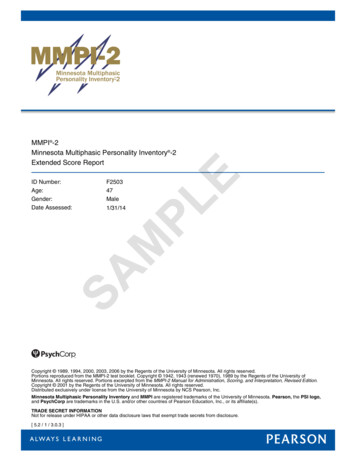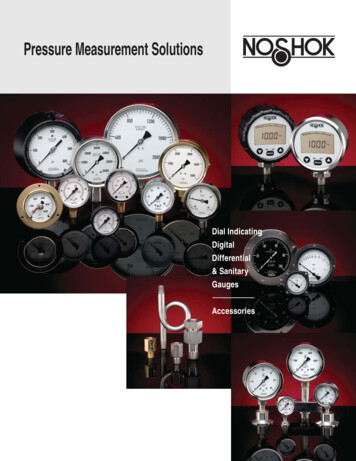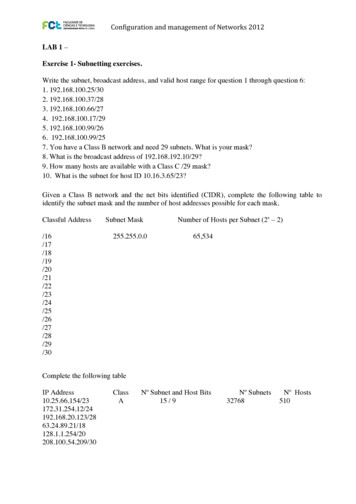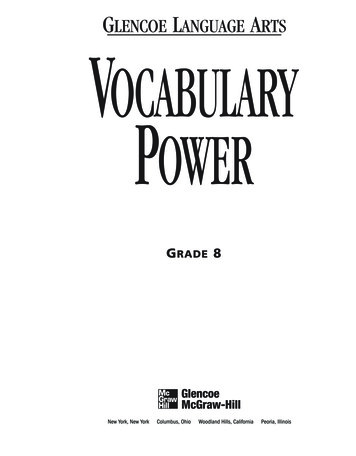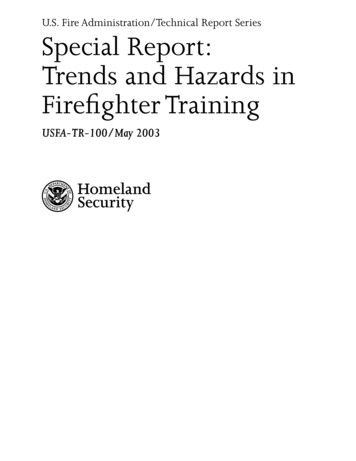
Transcription
U.S. Fire Administration/Technical Report SeriesSpecial Report:Trends and Hazards inFirefighter TrainingUSFA-TR-100/May 2003HomelandSecurity
U.S. Fire Administration Major Fire Investigations ProgramThe U.S. Fire Administration develops reports on selected major fires throughout the country.The fires usually involve multiple deaths or a large loss of property. But the primary criterionfor deciding to write a report is whether it will result in significant “lessons learned.” In somecases these lessons bring to light new knowledge about fire--the effect of building construction orcontents, human behavior in fire, etc. In other cases, the lessons are not new, but are serious enoughto highlight once again because of another fire tragedy. In some cases, special reports are developedto discuss events, drills, or new technologies or tactics that are of interest to the fire service.The reports are sent to fire magazines and are distributed at National and Regional fire meetings.The reports are available on request from USFA. Announcements of their availability are publishedwidely in fire journals and newsletters.This body of work provides detailed information on the nature of the fire problem for policymakerswho must decide on allocations of resources between fire and other pressing problems, and withinthe fire service to improve codes and code enforcement, training, public fire education, buildingtechnology, and other related areas.The Fire Administration, which has no regulatory authority, sends an experienced fire investigatorinto a community after a major incident only after having conferred with the local fire authoritiesto insure that USFA’s assistance and presence would be supportive and would in no way interferewith any review of the incident they are themselves conducting. The intent is not to arrive duringthe event or even immediately after, but rather after the dust settles, so that a complete and objectivereview of all the important aspects of the incident can be made. Local authorities review USFA’sreport while it is in draft form. The USFA investigator or team is available to local authorities shouldthey wish to request technical assistance for their own investigation.For additional copies of this report write to the U.S. Fire Administration, 16825 South Seton Avenue,Emmitsburg, Maryland 21727 or via USFA Web page at http://www.usfa.dhs.gov
Special Report:Trends and Hazards in Firefighter TrainingReported by: Adam ThielJeff SternJohn KimballNicole HankinThis is Report 100 of the Major Fires Investigation Project conductedby Varley-Campbell and Associates, Inc./TriData Corporation undercontract EMW-97-CO-0506 to the U.S. Fire Administration, FederalEmergency Management Agency, and is available from the USFA Webpage at http://www.usfa.dhs.govHomelandSecurityDepartment of Homeland SecurityUnited States Fire AdministrationNational Fire Data Center
U.S. Fire AdministrationMission StatementAs an entity of the Department of HomelandSecurity, the mission of the USFA is to reduce life and economic losses due to fireand related emergencies, through leadership, advocacy, coordination, and support.We serve the Nation independently, in coordination with other Federal agencies,and in partnership with fire protection andemergency service communities. With acommitment to excellence, we provide public education, training, technology, and datainitiatives.HomelandSecurity
ACKNOWLEDGMENTSThe United States Fire Administration greatly appreciates the cooperation received from the following people and organizations during the preparation of this report:International Society of Fire Service InstructorsAssistant Chief Roger A. McGary, Montgomery County (MD) Division of Fire and Rescue ServicesMaryland Fire and Rescue InstituteMr. Steven T. Edwards, DirectorMr. Russell Strickland, Assistant Director— Field ProgramsNorth Carolina Department of Insurance Fire and Rescue Services DivisionMr. Tim BradleyThe Maryland Council of Fire and Rescue AcademiesNational Fire Protection AssociationIn addition, the following individuals served as peer reviewers for this report, providing invaluableinsight and expertise. We are grateful for their participation.Mr. James ArnoldProgram Manager, Public SectorFire Protection Training DivisionTexas A & M University, Engineering Extension ServiceTim RogersBattalion ChiefCharlotte, NC Fire DepartmentDouglas Stutz, Ph.DDirector, School of Fire and Environmental SciencesMetro-Dade Community CollegeMiami, FL
TABLE OF CONTENTSINTRODUCTION. . . . . . . . . . . . . . . . . . . . . . . . . . . . . . . . . . . . . . . . . . . . . . . . . . . . . . . . . . . . .summary of KEY ISSUES. . . . . . . . . . . . . . . . . . . . . . . . . . . . . . . . . . . . . . . . . . . . . . . . . . . . . .BACKGROUND. . . . . . . . . . . . . . . . . . . . . . . . . . . . . . . . . . . . . . . . . . . . . . . . . . . . . . . . . . . . . . .TRAINING INCIDENTS. . . . . . . . . . . . . . . . . . . . . . . . . . . . . . . . . . . . . . . . . . . . . . . . . . . . . . . .One firefighter killed, two injured in live fire training exercise. . . . . . . . . . . . . . . . . . . . . . . . .Recruit killed during physical training. . . . . . . . . . . . . . . . . . . . . . . . . . . . . . . . . . . . . . . . . . .Two firefighters injured during demonstration in improvised structure . . . . . . . . . . . . . . . . . .1233344Three firefighters burned in improvised training structure during search and rescue . . . . . . . . 5Chem-bio training leads to near fatal exposure to toxic products . . . . . . . . . . . . . . . . . . . . . . . 5Near miss when aerial ladder contacts high voltage electrical wires during training. . . . . . . . . 5Marine firefighting session injures instructor . . . . . . . . . . . . . . . . . . . . . . . . . . . . . . . . . . . . . . 5Apparatus accident injures firefighter, damages new engine . . . . . . . . . . . . . . . . . . . . . . . . . . . 6Recruit injured during power saw operations. . . . . . . . . . . . . . . . . . . . . . . . . . . . . . . . . . . . . . 6Firefighters injured in ad hoc training evolution. . . . . . . . . . . . . . . . . . . . . . . . . . . . . . . . . . . . 6Deviation from established training procedures results in a near tragedy during a firetraining exercise. . . . . . . . . . . . . . . . . . . . . . . . . . . . . . . . . . . . . . . . . . . . . . . . . . . . . . . . . 6TRAINING CASUALTY DATA. . . . . . . . . . . . . . . . . . . . . . . . . . . . . . . . . . . . . . . . . . . . . . . . . . . . 7Fire Service Training Standards and Regulations. . . . . . . . . . . . . . . . . . . . . . . . . . . 9The NFPA. . . . . . . . . . . . . . . . . . . . . . . . . . . . . . . . . . . . . . . . . . . . . . . . . . . . . . . . . . . . . . . . . 9Local, State, and Federal Regulations. . . . . . . . . . . . . . . . . . . . . . . . . . . . . . . . . . . . . . . . . . . . 11COMMON HAZARDS IN TRAINING. . . . . . . . . . . . . . . . . . . . . . . . . . . . . . . . . . . . . . . . . . . . . 12Live Fire Training . . . . . . . . . . . . . . . . . . . . . . . . . . . . . . . . . . . . . . . . . . . . . . . . . . . . . . . . . . 12Other Types of Firefighter Training . . . . . . . . . . . . . . . . . . . . . . . . . . . . . . . . . . . . . . . . . . . . . 14Physical Stress. . . . . . . . . . . . . . . . . . . . . . . . . . . . . . . . . . . . . . . . . . . . . . . . . . . . . . . . . . . . . 15Unsafe Practices . . . . . . . . . . . . . . . . . . . . . . . . . . . . . . . . . . . . . . . . . . . . . . . . . . . . . . . . . . . 15Background Knowledge, Skills, and Abilities 15Instructor and Officer Fire-Combat Experience. . . . . . . . . . . . . . . . . . . . . . . . . . . . . . . . . . . .Environmental Hazards. . . . . . . . . . . . . . . . . . . . . . . . . . . . . . . . . . . . . . . . . . . . . . . . . . . . . .LESSONS LEARNED. . . . . . . . . . . . . . . . . . . . . . . . . . . . . . . . . . . . . . . . . . . . . . . . . . . . . . . . . . .CONCLUSION. . . . . . . . . . . . . . . . . . . . . . . . . . . . . . . . . . . . . . . . . . . . . . . . . . . . . . . . . . . . . .APPENDIX: Montgomery County (MD) Fire and Rescue ServicesLive Fire Training Safety Documentation for NFPA 1403 . . . . . . . . . . . . . . . . .1616171819
xU.S. Fire Administration/Technical Report SeriesLIVE FIRE TRAINING REQUEST DOCUMENTATION. . . . . . . . . . . . . . . . . . . . . . . . . . . . . . . .SUMMARY CHECKLIST . . . . . . . . . . . . . . . . . . . . . . . . . . . . . . . . . . . . . . . . . . . . . . . . . . . . . . .Section I:. . . . . . . . . . . . . . . . . . . . . . . . . . . . . . . . . . . . . . . . . . . . . . . . . . . . . . . . . . . . . . . . .Property Owner Checklist. . . . . . . . . . . . . . . . . . . . . . . . . . . . . . . . . . . . . . . . . . . . . . . . . . . .Permission To Burn. . . . . . . . . . . . . . . . . . . . . . . . . . . . . . . . . . . . . . . . . . . . . . . . . . . . . . . . .Building Inspection Form. . . . . . . . . . . . . . . . . . . . . . . . . . . . . . . . . . . . . . . . . . . . . . . . . . . .Participants. . . . . . . . . . . . . . . . . . . . . . . . . . . . . . . . . . . . . . . . . . . . . . . . . . . . . . . . . . . . . . .section II: . . . . . . . . . . . . . . . . . . . . . . . . . . . . . . . . . . . . . . . . . . . . . . . . . . . . . . . . . . . . . . . .Command Structure:. . . . . . . . . . . . . . . . . . . . . . . . . . . . . . . . . . . . . . . . . . . . . . . . . . . . . . . .Live Fire Training Checklist: . . . . . . . . . . . . . . . . . . . . . . . . . . . . . . . . . . . . . . . . . . . . . . . . . .Planned Training Scenarios:. . . . . . . . . . . . . . . . . . . . . . . . . . . . . . . . . . . . . . . . . . . . . . . . . . .Plot Plan. . . . . . . . . . . . . . . . . . . . . . . . . . . . . . . . . . . . . . . . . . . . . . . . . . . . . . . . . . . . . . . . .Floor Plans:. . . . . . . . . . . . . . . . . . . . . . . . . . . . . . . . . . . . . . . . . . . . . . . . . . . . . . . . . . . . . . .Section III:. . . . . . . . . . . . . . . . . . . . . . . . . . . . . . . . . . . . . . . . . . . . . . . . . . . . . . . . . . . . . . . .Responsibilities Of Instructor In Charge. . . . . . . . . . . . . . . . . . . . . . . . . . . . . . . . . . . . . . . . .Responsibilities Of The Safety Officer. . . . . . . . . . . . . . . . . . . . . . . . . . . . . . . . . . . . . . . . . . .Responsibility Of Instructor(s). . . . . . . . . . . . . . . . . . . . . . . . . . . . . . . . . . . . . . . . . . . . . . . .Responsibilities Of Support Personnel. . . . . . . . . . . . . . . . . . . . . . . . . . . . . . . . . . . . . . . . . . .Student’s Statement Of Training. . . . . . . . . . . . . . . . . . . . . . . . . . . . . . . . . . . . . . . . . . . . . . . .Participant List . . . . . . . . . . . . . . . . . . . . . . . . . . . . . . . . . . . . . . . . . . . . . . . . . . . . . . . . . . . .Immediate Pre-burn Procedures. . . . . . . . . . . . . . . . . . . . . . . . . . . . . . . . . . . . . . . . . . . . . . .Post Burn Procedures . . . . . . . . . . . . . . . . . . . . . . . . . . . . . . . . . . . . . . . . . . . . . . . . . . . . . . .21242527282932333435394041424345474849505154
INTRODUCTIONThe range of services provided by America’s fire service continues to expand. In many areas, thelocal fire department is responsible for mitigating hazardous materials incidents, performingtechnical rescues, and providing emergency medical services. The threat of terrorist incidentsfurther increases the fire department’s responsibility, as firefighters must be taught to recognize thesigns of a chemical or biological attack and the proper response. This expansion of the fire service’sresponsibilities means that less time and energy are available to focus on basic fire suppression skillsand scenarios. Also, some of the newer missions present their own, inherent training dangers.In addition, the personal protective gear being worn by firefighters today is excellent; some say thatit is even too protective. Firefighters now can advance deeper into structures and get closer to theseat of a fire than in years past because the turnout gear protects well against heat, but this can createproblems. A longer exposure to fire will rapidly deplete a firefighter’s energy and air supply; and thefirefighter will have a greater distance to travel to an exit in an emergency situation. Furthermore, asfirefighters progress farther into a structure, more time elapses, which means the fire is more developed, hotter, and often closer to flashover. Due to the increased use of synthetic and polycarbonateconstruction materials, fires are burning hotter and faster than in the past, resulting in a higherpotential for building collapse and flashover. Collapse becomes more likely because of the increaseddamage from the fire.Safe, effective, and realistic firefighter training is essential in preparing the fire service to achieve itsmission of preserving life and property. The dilemma posed by conducting realistic fire trainingis that fires, even in a training setting, are inherently dangerous. Yet, the fire service needs realisticscenarios to fully experience the environment of a fire and how to combat it. Even without the presence of live fire, training on the physically challenging and labor-intensive tasks of hose handling,tool work, and ladder operations pose a high potential for injuries.From 1987-2001 there has been a 31 percent decrease in the incidence of structure fires throughoutthe United States. As a result of the decline in fires, firefighters on the whole have less firegroundexperience than their predecessors had a generation ago. As many of the more experienced firefighters and officers retire, they are replaced by young officers with comparably less fire experience.As today’s firefighters’ collective, direct experience in fighting fires continues to diminish, there isgreat concern in the fire service that the inability to recognize flashover and building collapse—andto react quickly enough to avoid being caught by these two potentially fatal conditions—will continue to result in injuries and fatalities to firefighters. Complicating this situation is that live firetraining with Class A combustible materials (especially in acquired structures) is being replaced bytemperature-controlled, fuel-fed fires in non-combustible structures. Departments are relying lesson live fire training for myriad reasons, including among others, environmental, safety, and cost.This report examines recent injurious and fatal incidents involving training to determine lessonsthat can be used to prevent future injuries and deaths. The emphasis in this report is on fire-relatedtraining, particularly live-fire evolutions. It is, however, important to note that training-related inju-
2U.S. Fire Administration/Technical Report Seriesries can and do occur during a variety of types of training. Also included is a discussion of trainingstandards and common hazards as well as a brief analysis of the available data on the number andcause of training-related injuries and deaths.summary of KEY ISSUESIssueCommentsTraining injury dataSince 1987, reported training-related injuries have increased by nearly 21 percent. In 2001,almost 7,000 training-related injuries were reported, reinforcing the need to analyze trends in training-related injuries to determine how best to prevent future injuries and deaths.Burn buildings versusacquired structuresLive fire training buildings and simulators have made fire training safer than in the past, but generally do not provide the same quality of realism as live fire training in acquired structures.Controlled trainingtechniquesClosely controlled and repetitive procedures that simulate “actual” fire conditions have led tofireground injuries in cases where inexperienced firefighters have not been able to select themost appropriate tactical procedure. Firefighters must be taught to recognize the early signs offlashover and building collapse so they can take appropriate action quickly.Training standards andproceduresIn cases reviewed by this report in which serious injuries resulted, procedures from either theNFPA 1403 Standard or the department’s own established procedures were violated. Failureto follow well-established standards and procedures occurred in virtually every training injuryreviewed during this study.Need for improved health and wellness programsFirefighters continue to become injured or killed as a result of poor physical fitness. Improvedhealth and wellness programs can reduce firefighters’ risk for heart attack and stroke and betteroverall physical fitness can reduce the risk of other injuries (e.g., sprains/strains).New types of training withtheir inherent risksThe need to expand training to include technical rescue, hazardous materials, and EMS, forexample, has increased the types of training hazards to which firefighters can be exposed.Instructor expertiseToday’s fire service instructors are more qualified and well versed in instructional methodologiesthan in the past. However, they may not have the same level of fireground experience as previousinstructors, due in part to the decline in the number of structure fires over the past two decades.Less time available fortraining in basic evolutionsIn order to meet the demands of expanding fire service roles, advanced and technical trainingevolutions have increased, thus reducing the amount of time available to perform basic trainingevolutions on such subjects as hose, ladder, and tool work.New technologiescontribute to safetyModern, computerized burn buildings, fed by propane or natural gas, have many built-in safety features for conducting live fire training. Modern personal protective equipment, such as turnout gearand SCBA, provide greater escape time in dangerous conditions such as flashover. Simulationtechnology has increased the margin of safety in training.Future trendsNew technologies, such as virtual reality and other simulators, will inevitably become part of thetraining tools used by firefighters. These technologies can enhance, but not substitute for actual,live fire evolutions.
USFA-TR-100/May 20033BACKGROUNDThe purpose of this report is to identify key concerns regarding the hazards of firefighter trainingand to explore how the training hazards have changed. A goal of this report is to help fire departments reduce these hazards by offering suggestions based on the experiences of the study participants. Since behavior on the fireground is closely related to behavior on the training ground ordrill field, it stands to reason that correcting safety-related issues during firefighter training shouldtranslate into fewer fireground injuries and deaths. A well-known fire department saying is: “train asyou fight and fight as you train.”This report examines the state of safety in firefighter training as widely conducted in the UnitedStates. The results of this research are intended to help fire departments identify training hazards,improve the safety of trainees, and provide more effective and safe practical training. Although it isimpossible to identify every training hazard, this report will analyze several of the most commonhazards encountered during training evolutions. Some suggestions for addressing these hazards alsoare included.The broad nature of this topic, combined with the limited amount of available data, necessitated thatproject staff solicit information from a variety of sources. To ensure broad input for the report, interviews were conducted with administrators, trainers, and other fire department personnel concernedwith fire-rescue training. These interviews were informal, but structured as guided discussions.Several meetings were conducted with local and state fire training officers to obtain information anddevelop a subjective sense of the key issues related to safe fire training. Project staff also conductedinformal interviews with instructors and officers at several conferences, including the Fire DepartmentInstructor’s Conference in Indianapolis held in the spring of 1998. A wide array of literature on firetraining was also reviewed using the National Fire Academy’s Learning Resources Center.TRAINING INCIDENTSIn the course of research for this study, a number of well-documented incidents were reviewed. Also,anecdotal information was provided by interviewees who related situations where training exercisesresulted in minor injuries or very close calls. The following examples demonstrate the nature andextent of training hazards and their impact.One firefighter killed, two injured in live fire training exerciseIn September 2001, a firefighter died and two firefighters were injured while participating in amulti-agency, live-burn training evolution. Two of the firefighters were playing the role of firefighters in distress on the second floor. They became trapped when the training fire progressed up thestairwell, accelerated by a foam mattress, which had been ignited on the first floor. Two victims(including the deceased) were found in the upstairs bedroom where they had been positioned forthe scenario; a third firefighter jumped to safety from a rear bedroom on the second floor.The deceased had only been a volunteer for several weeks and had not received any formal fire suppression training before the live burn evolution. Following the incident, investigators found numerous violations of NFPA 1403, including the use of personnel as victims, the absence of training in thecase of the firefighter who died, the lack of charged hoselines prior to ignition, and the placementof training fires near egress routes. In addition, the department’s First Assistant Chief was convictedof criminally negligent homicide for his actions leading up to and during the incident.
Recruit killed during physical trainingIn July 2002, a recruit died while participating in physical training. His death occurred on the thirdday of recruit school; it was only the second day his class had participated in physical training. Fortheir first physical training session the recruits ran approximately 2.78 miles. The next day, theirphysical training included a run of over 4 miles, a session of calisthenics, wind sprints, and jumpingjacks. The heat index that morning ranged from 80 degrees Fahrenheit at 0700 when training beganto 99 degrees Fahrenheit at 0825 when the recruit was en route to the hospital. He was pronounceddead an hour later with the cause of death listed as hyperthermia.The department’s Board of Inquiry found the following circumstances led to the recruit’s death: The recruits had no opportunity or means to hydrate themselves during physical training. There was an unacceptable ratio of instructors to students; only one instructor was responsible for overseeing the recruits on the morning of the incident. The instructor leading the physical training session did not have a portable radio or cellphone to use in case of emergencies. There was a delay in activating an EMS response because the recruit’s condition was notinitially recognized as a true medical emergency.Two firefighters injured during demonstration in improvised structureAt a department open house in 1996, two firefighters received minor burn injuries during a firefighting demonstration involving a mock-up of a house. The structure (12-1/2 feet by 7 feet by 7foot), made of furniture crates, was designed to look like a house so that the fire department couldsimulate a fire attack for the public. The firefighters who entered the fully involved structure receivedfirst and second degree burns. The department’s own review indicated that failure to provide seniorlevel supervision and to comply with the 1992 edition of NFPA 1403 contributed to the outcome.Included in the findings were: There was no single officer in charge. No safety officer or rapid intervention crew was designated. Vertical ventilation was not conducted. The injured firefighters and the officer did not have sufficient experience for the structuralfirefighting demonstration. The firefighters had received initial training in a propane-fueled burn building. They hadnot, however, been taught how to attack a fire that was engulfing or blowing out of a door,as was the case in the demonstration. The improvised structure was totally inappropriate for any entry for training or demonstration purposes.The department has since adopted NFPA 1403 Standard (1997 Edition) as its live fire trainingpolicy.
USFA-TR-100/May 20035Three firefighters burned in improvised training structure during search and rescueIn late 1992, three firefighters were seriously burned while conducting training in a modified schoolbus that had been converted for use as a search and rescue simulator. The windows of the bus hadbeen welded shut, no roof ventilation holes were cut, and the front door had accidentally jammedshut after the trainees and the instructor entered the bus. The operation had no incident commandsystem, no safety officer, no back-up line, and no emergency medical standby.The training evolution consisted of firefighters entering a burning, smoke-filled structure and completing search and rescue without a hoseline. No check was made of the firefighters’ gear as theywent into the former passenger area of the bus.The fire had been allowed to pre-burn for 10 minutes. Conditions degenerated into flashover whilethe crew was inside. One firefighter was trapped inside after the disorganized exit by the others. Hewent into respiratory arrest as he was removed from the bus, and he was revived. That firefighterspent over two months in a critical care burn unit. Two others were less seriously burned, butrequired weeks of care in burn units.One of the major lessons of this incident was the recognition of the inappropriate nature of suchimprovised structures (e.g., a modified school bus) for such a hazardous operation. The near-totallack of organization and safety procedures is also a major lesson from this unfortunate incident.Chem-bio training leads to near fatal exposure to toxic productsIn 1997, a member of a unit training to respond to a chemical incident was overcome by a nerveagent and exhibited signs and symptoms of central nervous system injury (seizures). This live-agenttraining evolution was designed to familiarize the student with the proper use of their protectiveequipment and clothing. Fellow students had to deliver doses of an antidote to stop the seizure.Near miss when aerial ladder contacts high voltage electrical wires during trainingIn 1994, two firefighters narrowly escaped serious injury while conducting aerial training on thefront ramp of their fire station. The firefighters were under the supervision of an experienced firefighter when he was called to the phone. The two firefighters, who were on the turntable of the ladder truck, decided to raise the ladder out of its bedded position while their colleague was away fromthe scene. Due to an incline at the front ramp of the station, the turntable free-rotated directly intohigh voltage power lines that ran in front of the firehouse, energizing the aerial ladder and burning afour foot hole through the asphalt under one of the ladder’s jack plates. The two firefighters did notknow how to engage the manual, turntable brake to prevent the ladder from turning. Firefightersinside the station calmed the firefighters until the power company could de-energize the wires.The firefighters were unhurt (the ladder truck sustained some damage and subsequently had to bereturned to the manufacturer for repair).Marine firefighting session injures instructorIn 1998, one firefighter was injured when the use of gasoline at a marine firefighting training sessionled to a vapor explosion. His hand was burned when he removed a glove to light the training fire.Marine firefighting is not addressed under NFPA 1403, but the individual survived with minor injuries,primarily because he was wearing full turnout gear and SCBA, which is required by NFPA 1403.
Apparatus accident injures firefighter, damages new engineA firefighter was injured in 1998 when the engine in which he was riding rolled over during drivertraining. The incident occurred on the fire department’s driver training course. The driver panickedwhile descending a hill, and stepped on the accelerator instead of the brake. He received minorinjures; the engine, a newly delivered unit that had not yet been placed in service, was severelydamagedRecruit injured during power saw operationsA pair of experienced instructors was directing a group of recruits in the use of a gasoline- poweredrescue saw on automobiles. One evolution involved cutting an auto door at the hinge assembly.After one such activity, one of the recruits told an officer that something hit his foot, but that he“was all right.” Several exercises later, the recruit told the officer “his foot really hurt and he didn’tfeel well.” The officer called for EMS support.Examination revealed that one of the latch springs had apparently been propelled by the saw bladeinto the top of his foot. The spring hit beyond the area covered by the steel toe of the standard firefighter boot, penetrating the rubber boot and piercing the dorsalis pedis artery. The recruit sufferedserious blood loss, was treated for shock, and was transported to a medical care facility. This incidentemphasizes the need for scrutiny of all injuries, no matter how minor they may appear, and have EMSsupport available at all times during practical evolutions.Firefighters injured in ad hoc training evolutionAn engine company was participating in regularly scheduled training evolutions at their academywhen an officer suggested a maneuver he had seen in a trade magazine. The evolution involvedescape from flashover conditions utilizing a ground ladder at an extremely low angle placed belowthe sill of the “escape” window. Permission was g
Burn buildings versus acquired structures Live fire training buildings and simulators have made fire training safer than in the past, but gener-ally do not provide the same quality of realism as live fire traini
